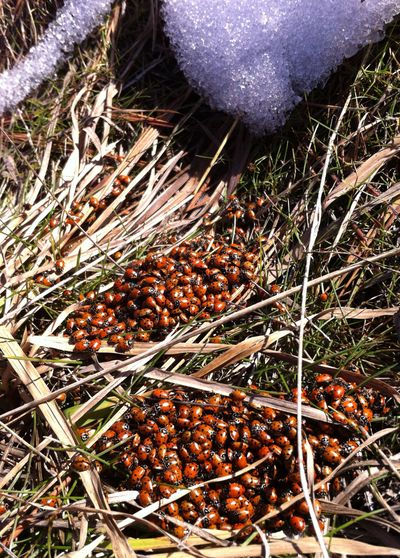Munts: Lady beetles will nibble plants, feast on pests

I got a bit of a surprise last week when John Hancock emailed me a picture of an enormous cluster of adult lady beetles he found basking in the sun at his Deep Creek home.
They appeared to have been overwintering in the grass and were taking advantage of the first sun since the snow melted. As it was way too early for them to come out, they likely warmed themselves for awhile and then retreated back to the shelter of the sod for a few more weeks.
Lady beetles are also known as ladybugs or ladybirds, depending on what part of the world you live in. They are a member of the coccinellidae family. They have a characteristic hard, shelled body, chewing mouth parts, six short legs and two pairs of wings. The wings are hidden under the shell on their backs. They come in many shades of brown, yellow, orange and red and can have many combinations of black or yellow spots and a few that don’t have any spots at all.
Both adult lady beetles and their grub-stage larvae are voracious predators of other insects. While each species of lady beetle has its preferences, they have an appetite for aphids, scale, spider mites, mealybugs, mites and insect eggs. The larvae can eat their body weight each day.
Attracting lady beetles to your garden means learning to live with a reasonable amount of bug damage caused by their favorite prey. That means not going after the aphids on your roses, spider mites in your junipers or mites in the vegetables as soon as you see them. Think of it this way: By living with the damage, you are setting a banquet table and just waiting for the guest of honor, the lady beetle, to arrive. In the end they get a feast and you don’t use as many chemicals. Over time, the populations of lady beetles will ebb and flow with the populations of their favorite prey.
Once the lady beetles have knocked back the population of bugs, you will need to provide them with alternative sources of food and shelter. Plant members of the carrot, aster and mustard families among your garden plants to provide them with sources of pollen and nectar and a place to land and sun themselves.
Leave the edges or remote corners of the garden a little on the rough side to provide spaces for breeding and resting. Group plants of varying heights and densities in blocks or as a hedgerow to provide different levels of habitat. Try to plan for a succession of blooms through the seasons so pollen and nectar reserves are always available.
Avoid buying packages of lady beetles from the nursery or online. They tend to wander away quickly from your garden searching for prey. You may also introduce nonnative species of lady beetles that will have a hard time establishing themselves or conflict with our native species.